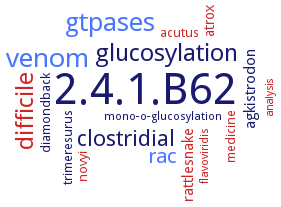2.4.1.B62: small GTPase glucosyltransferase
This is an abbreviated version!
For detailed information about small GTPase glucosyltransferase, go to the full flat file.

Reaction
Synonyms
Clostridium sordellii lethal toxin, cytotoxin B, cytotoxin L, glucosyltransferase TcdA, glucosyltransferase TcdB, haemorrhagic toxin, hemorrhagic toxin, letal toxin, lethal toxin, lethal-toxin, TcdA, TcdB, TcsH, TcsL, toxA, ToxB, toxin, toxin A, toxin B
ECTree
Advanced search results
Crystallization
Crystallization on EC 2.4.1.B62 - small GTPase glucosyltransferase
Please wait a moment until all data is loaded. This message will disappear when all data is loaded.
catalytic fragment of toxin B in the presence of UDP-glucose and Mn2+, to 2.2 A resolution. Toxin B belongs to the glycosyltransferase type A family. The reaction proceeds probably along a single-displacement pathway. The C1'' donor carbon atom position is defined by the bound UDP and glucose. The relative orientation of toxin B and substrate RhoA is consistent with both being attached to a membrane
crystal structures of the toxin A glucosyltransferase domain in the presence and absence of the co-substrate UDP-alpha-D-glucose, to 2.2 and 2.6 A resolution, respectively
enzyme contains an internal cysteine protease domain allosterically regulated by the eukaryotic-specific molecule inositol hexakisphosphate. Apo-cysteine protease is in dynamic equilibrium between active and inactive states. Inositol hexakisphosphate dramatically shifts this equilibrium towards an active conformer that is further restrained upon binding a suicide substrate. Residues within a beta-hairpin region functionally couple the inositol hexakisphosphate binding site to the active site
catalytic fragment, residues 1-551 to 2.85 A resolution. Geometry suggests that the reaction runs as a circular electron transfer in a six-membered ring, which involves the deprotonation of the nucleophile by the beta-phosphoryl group of the donor substrate UDP-glucose
catalytic fragment, residues 1-546, to 2.3 A resolution. Geometry suggests that the reaction runs as a circular electron transfer in a six-membered ring, which involves the deprotonation of the nucleophile by the beta-phosphoryl group of the donor substrate UDP-glucose


 results (
results ( results (
results ( top
top





